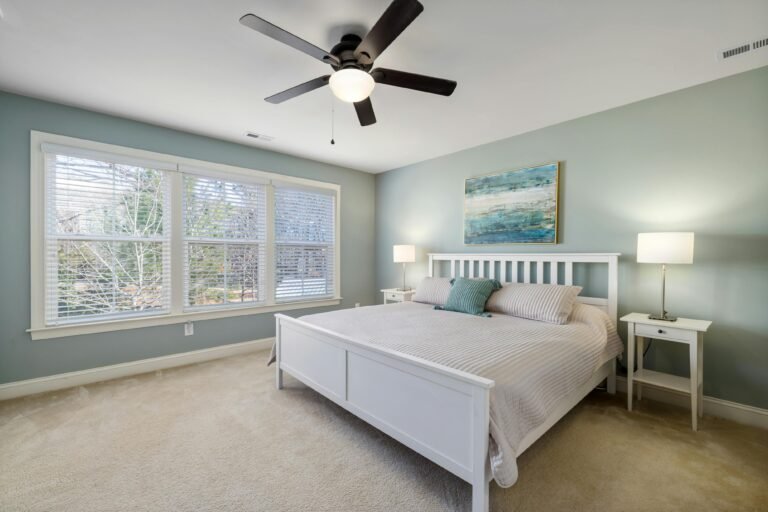Discover how a ceiling fan can keep you cool and save money today. Home experts, including advice from the US Department of Energy, note that proper air circulation boosts comfort.
Are you looking for a way to enhance your home’s comfort while keeping your energy bills in check? Look no further than the simple ceiling fan. This guide shows you how fans work and gives you practical tips for smart use.
The Magic of Air Circulation: How Ceiling Fans Work
Ceiling fans are not just decorations. They actively move air to improve your room’s climate.
The Wind-Chill Effect
Fans create a wind-chill effect by moving air around. The breeze helps sweat evaporate quickly, making you feel cooler even when the room’s temperature stays the same.
Energy Efficiency in Action
Fans do not cool the air like an air conditioner. They simply move the air so a room can feel up to 4°F cooler. This lets you raise your thermostat by about 4 degrees in summer and save energy.
Pro Tip: For best results in summer, set your fan to rotate counterclockwise so that air flows downward.
Choosing the Right Ceiling Fan: Size Matters
Pick the right fan for your room to get the best performance and look.
Room Size and Fan Diameter
- Small rooms (up to 75 sq ft): 29-36 inch fan
- Medium rooms (76-144 sq ft): 36-44 inch fan
- Large rooms (144-225 sq ft): 50-54 inch fan
- Great rooms (225+ sq ft): 60-72 inch fan
Ceiling Height
For safety and good air flow, keep fan blades at least 7 feet above the floor and 8-9 inches below the ceiling. Use a downrod if your ceiling is high.
Pro Tip: In rooms with low ceilings, choose low-profile or “hugger” fans that mount close to the ceiling.
Smart Fans: The Future of Home Comfort
Smart ceiling fans add modern convenience to your home. They offer remote control and energy monitoring features.
Remote Control and Scheduling
You can control your fan with your smartphone or set schedules to change the fan speed automatically.
Integration with Smart Home Systems
Some fans work with voice assistants like Alexa or Google Home, letting you control them with your voice.
Energy Monitoring
Advanced models track energy use. This helps you set the fan to the most energy-efficient setting.
Pros of Smart Fans:
- Easy control options
- Saving energy with automation
- Works with other smart devices
Cons of Smart Fans:
- Higher initial price
- Needs Wi-Fi for full use
- May have technical issues
Reversible Fans: Year-Round Comfort
You can use a reversible fan in both summer and winter. Change the rotation to fit the season.
Summer Mode (Counterclockwise)
In summer, set the fan to rotate counterclockwise. This pushes air down and creates a cooling breeze.
Winter Mode (Clockwise)
In winter, change the rotation to clockwise. This move pushes warm air from the ceiling down into the room.
Pro Tip: Use low speed in winter mode to avoid a cooling effect.
Installation and Maintenance: Keeping Your Fan in Top Shape
Good installation and regular checks make your fan work safely for many years.
Installation Basics
- Make sure the electrical box can hold the fan
- Use a mounting bracket made for ceiling fans
- Follow the manufacturer’s directions or hire a pro
Maintenance Tips
- Clean the blades often to remove dust
- Tighten screws and bolts every year
- Oil the motor as the maker recommends
- Listen for sounds that show a problem
Pro Tip: When cleaning, use a pillowcase over the blades to trap dust and debris.
Energy Savings: The Numbers Do Not Lie
Ceiling fans use very little power. A typical fan uses 30 to 70 watts, while a central air conditioner uses around 3500 watts.
- Average monthly AC cost: $100
- Potential savings with fans: $40
- Annual savings: $480
These savings can repay the cost of your fan quickly. It is a smart way to boost comfort and save money.
Design and Aesthetics: Finding Your Perfect Fan
Today’s ceiling fans come in many styles that fit any home decor. They work well with modern, rustic, or traditional looks.
Popular Styles
- Modern: Clean lines with minimalist design and built-in LED lights
- Tropical: Wide blades that bring a vacation feel
- Industrial: Metal finishes that suit urban lofts
- Traditional: Classic styles with ornate details and wood accents
Blade Materials
- Wood: Offers a classic look and reduces noise
- Metal: Provides a modern look and is easy to clean
- Plastic: Lightweight and budget friendly
Pro Tip: For outdoor spots like patios, use fans rated for damp or wet areas.
Conclusion: A Cool Investment for Your Home
Ceiling fans are a smart, energy-saving tool for your home. They boost comfort and cut energy bills by circulating air well.
- Improves comfort all year
- Saves energy costs
- Enhances indoor air flow
- Fits many decor styles
Choose a fan that fits your room, install it right, and use it wisely for the best results.
Ready to improve your home comfort? Check out this ceiling fan: https://amzn.to/4dtdYTK
As an Amazon Associate, I earn from qualifying purchases.
Frequently Asked Questions
How does a ceiling fan make me feel cooler?
The moving air helps sweat evaporate, which makes you feel cooler.
What size fan should I choose for my room?
Select a fan based on your room size. Use the guide in the article to choose the best diameter.
How do smart fans save energy?
Smart fans let you schedule fan speeds and track energy use. This helps lower your energy bills.
Last updated on May 19, 2025







